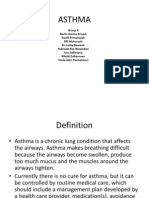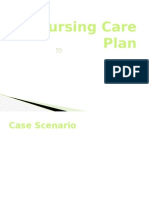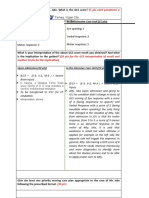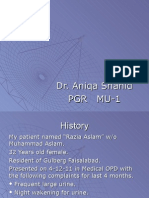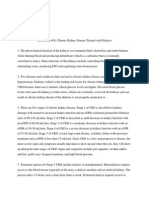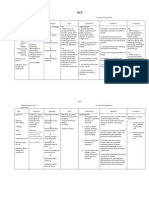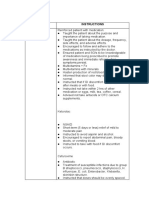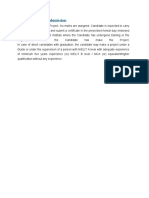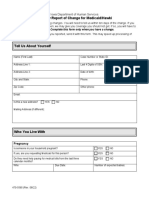NCP Mods
NCP Mods
Uploaded by
Nickos Andrew Magno Asanza Jr.Copyright:
Available Formats
NCP Mods
NCP Mods
Uploaded by
Nickos Andrew Magno Asanza Jr.Original Description:
Original Title
Copyright
Available Formats
Share this document
Did you find this document useful?
Is this content inappropriate?
Copyright:
Available Formats
NCP Mods
NCP Mods
Uploaded by
Nickos Andrew Magno Asanza Jr.Copyright:
Available Formats
Multiple organ dysfunction syndrome (MODS) occurs when altered organ function in an acutely illpatient is present to the extent
that homeostasis can no longer be maintained without intervention. MODS was formerly known as multiplesystem organ failure. The usual sequence of MODS depends somewhat on its cause but often begins with pulmonary failure 2 to 3 days after surgery, followed, in order, by hepatic failure, stress-induced gastrointestinal (GI) bleeding, and renal failure. Mortality rates are linearly related to the number of failed organ systems. Patients with two or more organ systems involved have a mortality rate of approximately 75%, and patients with four organ systems involved have a 100% mortality rate. MODS was first associated with traumatic injuries in the late 1960s and has subsequently been associated with infection and decreased perfusion to any part of the body. The term MODS was adopted in 1991 at a consensus conference of the Society of Critical Care Medicine and the American College of Chest Physicians. The term MODS best describes the organ dysfunction that precedes complete failure. Primary MODS, the result of a direct injury or insult to the organ itself, is initiated by a specific precipitating event, such as a pulmonary contusion. The injury or insult causes an inflammatory response within that organ system, and dysfunction develops. Secondary MODS develops as the result of a systemic response to infection or inflammation. Systemic inflammatory response syndrome (SIRS) is an overwhelming response of the normal inflammatory system, producing systemic effects instead of the localized response normally seen. The inflammatory response is
produced by the activation of a series of mediators and results in alterations in blood (selective vasodilation and vasoconstriction), an increase in vascular permeability, white blood cell (WBC) activation, and activation of the coagulation cascade. Mortality rates are high with MODS, and the more organ systems that fail, the higher the mortality. For example, mortality with two-organfailure is 45% to 55%, higher than 80% with threeorgan failure, and approaches 100% if the failure of three or more organs persists longer than several days. The inflammatory response can be triggered by any event, but it is most often associated with a bacterial infection. The events most often associated with the development of SIRS and MODS are shock, trauma, burns, aspiration, venomous snakebites, cardiac arrest, thromboemboli, myocardial infarction, operative procedures, vascular injury, infection, pancreatitis, and disseminated intravascular coagulation (DIC). Nursing care plan assessment and physical examination The patient with MODS has a history of infection, tissue injury, or a perfusion deficit to an organ or body part. Often, this injury or insult is not life-threatening but exposes the person to bacterial contamination. Question the patient (or, if the patient is too ill, the family) to identify the events in the initial insult and any history of preexisting organ dysfunction, such as chronic lung disease, congestive heart failure, and diabetes mellitus. Elicit a complete medication history and the patients compliance with medications, and ask if the patient has experienced recent weight loss. Determine the patients dietary patterns to assess the patients nutritional status. Take a history of the patients use of cigarettes, alcohol, and other drugs of abuse.
The physical examination of the patient with MODS varies, depending on the organ systems involved and the severity of their dysfunction (Table 3). Expect the patient to develop signs of pulmonary failure first and then hepatic failure and GI bleeding. Renal failure follows. Note that failures of the central nervous system (CNS) and the cardiovascular system are late signs of MODS. The patient with MODS may be fully conscious, partially conscious, or unconscious. If the patient is oriented, she or he is likely to be very anxious and fatigued and also confused, lethargic, or comatose. Assess the patients ability to cope with a prolonged lifethreatening illness and the changes in roles that a severe illness brings. The patient may experience fear because of a real threat to her or his life. Nursing care plan primary nursing diagnosis: Risk for infection related to microorganism invasion, immunosuppression, malnutrition, and presence of invasive monitoring devices. Nursing care plan intervention and treatment plan Management of the patient with MODS begins with the recognition of those patients who are at an increased risk for the syndrome. Care must be taken to prevent infection and maintain adequate tissue oxygenation to all body parts. Despite improvement in medical therapies, the mortality rate of MODS remains high. Treatment of the patient with MODS can be divided into four main areas: anti-infectives, maintenance of tissue perfusion and
oxygenation, nutritional support, and immunomodulation. Antiinfective therapy is guided by culture and sensitivity reports. Any potential source of infection should be investigated and eliminated. Antifungal and antiviral agents are used primarily with immunocompromised patients, who are especially susceptible to fungal and viral infections. Maintaining and monitoring tissue perfusion and oxygenation are crucial to the survival of the patientwith MODS. Measurement of oxygen delivery and consumption is necessary to guide fluid replacement therapy and inotropic support of cardiac function. To maximize all components of oxygen delivery (in particular, cardiac index, hemoglobin, and oxygen saturation), the physician maintains the hematocrit within the normal range or even at a supranormal level with blood transfusions. Mechanical ventilation with positive end-expiratory pressure and modes such as pressure control ventilation and inverse ratio inspiration expiration are used to maintain adequate oxygenation and oxygen delivery. The success of maintaining oxygen delivery is evaluated by following the trend of oxygen consumption. Metabolic demands dramatically increase in MODS. When oxygen delivery cannot meet the bodys metabolic demands, these demands may be decreased with sedation, pharmacologic paralysis, and temperature control. The goal in the future is to develop medications that allow for immunomodulation therapy to alter the detrimental effects of the systemic immune-inflammatory response. Tumor necrosis factor and IL-1 are two cytokines that exert a broad effect on the endothelium, leukocytes, and fibroblasts. Experts hope that modulation of both of these cytokines can decrease many of the bodys responses to inflammation. The presence of endotoxin, a substance that is
released with the destruction of gram-negative bacteria, stimulates the inflammatory response. Modulation of endotoxin would also decrease many of the bodys responses to inflammation. Any potential source of infection should be eliminated if possible. Change the dressing on all invasive line sites and surgical wounds according to protocol to keep the area free of infection and to monitor for early signs of infection. Maintain aseptic technique with all dressing changes and manipulation of intravenous lines. Institute the measures that are necessary to prevent aspiration when patients are placed on enteral feedings. Keep the head of the bed elevated, and check for residual volume and tube placement every 4 hours. To limit the patients oxygen expenditure, provide frequent rest periods and create a quiet environment whenever possible. Schedule procedures and nursing care interventions so that the patient has periods of uninterrupted rest. Manage situations of increased metabolic demand such as fever, agitation, alcohol withdrawal, and painpromptly so that the patient conserves energy and limits oxygen consumption. Monitor the patients environment for sensory overload. Provide purposeful, planned stimuli and keep extraneous, constant noises to a minimum. Provide for planned, uninterrupted rest periods to avoid sleep deprivation. Monitor bony prominences and areas of high risk for skin breakdown. Note that MODS is one of the most critical illnesses that a patient can develop. Although the patient might be well sedated and unresponsive, the family or significant others are generally very anxious, upset, and frightened that the patient might not survive.
These fears are realistic, particularly if multiple organs are involved. Provide the significant others with accurate information about the patients course and his or her prospects for recovery. Encourage the legal representative to participate in decisions about extraordinary measures to keep the patient alive if the patient cannot speak for himself or herself. Determine if the patient has a living will or has discussed his or her desire to be kept alive by technology during a potentially terminal illness. If the decision is to terminate life support, work with the significant others to provide a dignified death for the patient in an environment that allows the family to participate and grieve appropriately. Provide referrals to the chaplain, clinical nurse specialist, or grief counselor as needed. Nursing care plan discharge and home health care guidelines Although no specific adaptive structural changes need to be made, near the time of discharge assess the patients individual needs. Because organ dysfunction or failure is individualized, home care preparation should be based on meeting the individuals needs. Be sure the patient understands all medications prescribed, including dosage, route, action, and side effects. Describe the importance of avoiding fatigue and taking frequent rests. Teach the patient to eat small, frequent meals to maintain adequate nutrition. Teach the patient any needed postoper
You might also like
- Contemporary Nursing TheoriesDocument13 pagesContemporary Nursing Theoriessagami.gNo ratings yet
- Nursing Theory: Asthma (Presentation)Document13 pagesNursing Theory: Asthma (Presentation)vinda astri permatasari100% (1)
- Reflective EssayDocument2 pagesReflective EssayAnonymous 0CdrZVNo ratings yet
- CASE STUDY (Gastro)Document3 pagesCASE STUDY (Gastro)Jake Yvan DizonNo ratings yet
- Hypertension, Anxiety, Airway NCPDocument6 pagesHypertension, Anxiety, Airway NCPHana Sanchez AlobaidanNo ratings yet
- NCP - Poststreptococcal GlomerulonephritisDocument12 pagesNCP - Poststreptococcal GlomerulonephritisAya BolinasNo ratings yet
- Chromosome AberrationsDocument27 pagesChromosome AberrationsSabinaNo ratings yet
- Republic ActDocument36 pagesRepublic ActjanNo ratings yet
- Acute PyelonephritisDocument105 pagesAcute Pyelonephritisyasira50% (2)
- NCP Micu Hascvd Cad - RioDocument5 pagesNCP Micu Hascvd Cad - RioRio BonifacioNo ratings yet
- DP Discharge Plan@@@@@@@@Document6 pagesDP Discharge Plan@@@@@@@@Maemae SumalinogNo ratings yet
- School of Health and Allied Health Sciences Nursing Department Self-Directed Learning (Nur 146 - Clinical Area)Document3 pagesSchool of Health and Allied Health Sciences Nursing Department Self-Directed Learning (Nur 146 - Clinical Area)Duchess Juliane Jose MirambelNo ratings yet
- Upon Admission (15 PTS) in The Intensive Care Unit (15 PTS) : ? (5 Pts Each Parameter A Total of 15 Points)Document5 pagesUpon Admission (15 PTS) in The Intensive Care Unit (15 PTS) : ? (5 Pts Each Parameter A Total of 15 Points)Janelle Cabida SupnadNo ratings yet
- 13 Areas of Assessment - SumbadDocument4 pages13 Areas of Assessment - SumbadMb SumbadNo ratings yet
- Anatomy and Physiology PneumoniaDocument4 pagesAnatomy and Physiology PneumoniaJohnson MallibagoNo ratings yet
- RRLDocument4 pagesRRLAnnalyn MantillaNo ratings yet
- Diabetes InsipidusDocument48 pagesDiabetes InsipidusAhmed Fraz MamoonNo ratings yet
- Chicken Pox NCPDocument3 pagesChicken Pox NCPrshin96No ratings yet
- NCP For CHNDocument2 pagesNCP For CHNJhielo ArambulaNo ratings yet
- Case Study - Dengue Fever V - S UtiDocument12 pagesCase Study - Dengue Fever V - S UtiHarlene Joyce ReyNo ratings yet
- Case Scenario 1: Benign Prostatic Hyperplasia: Aldrin M. Paulino BSN 3ADocument4 pagesCase Scenario 1: Benign Prostatic Hyperplasia: Aldrin M. Paulino BSN 3A24 PAULINO ALDRIN MUJARNo ratings yet
- Physical Examination and Review of Systems: Involuntarily Blinking Pink ConjunctivaDocument3 pagesPhysical Examination and Review of Systems: Involuntarily Blinking Pink ConjunctivaJulianne B. Dela Cruz100% (1)
- Factors Affecting Nurse Performance in Medical WardDocument6 pagesFactors Affecting Nurse Performance in Medical Wardifa pannyaNo ratings yet
- Subjective Data: Short Term Goal: IndependentDocument1 pageSubjective Data: Short Term Goal: IndependentVanetNo ratings yet
- Scribd 020922 Case Study-Oncology A&kDocument2 pagesScribd 020922 Case Study-Oncology A&kKellie DNo ratings yet
- 419Document6 pages419Maxine RicafortNo ratings yet
- Case Study Icu Sem 6Document30 pagesCase Study Icu Sem 6BM2-0619 Mohd Khairul Naaim Bin PenchariNo ratings yet
- Case Study: Gastrointestinal System of Older People Case Scenario: LapayDocument1 pageCase Study: Gastrointestinal System of Older People Case Scenario: LapayAriaNo ratings yet
- Chapter 056Document19 pagesChapter 056Michael SamaniegoNo ratings yet
- Ov Ov OvDocument15 pagesOv Ov OvHayyana Mae Taguba LadiaNo ratings yet
- Acute PyelonephritisDocument59 pagesAcute PyelonephritisKylie Golindang100% (1)
- Goso Opd Day 2Document1 pageGoso Opd Day 2Johanisa SultanNo ratings yet
- Case Study 18Document4 pagesCase Study 18api-271284613No ratings yet
- Chronic Kidney Disease (CKD) : Diabetes High Blood Pressure Responsible For Up To Two-Thirds GlomerulonephritisDocument6 pagesChronic Kidney Disease (CKD) : Diabetes High Blood Pressure Responsible For Up To Two-Thirds GlomerulonephritisKyle Ü D. CunanersNo ratings yet
- College of Nursing Allied Health SciencesDocument38 pagesCollege of Nursing Allied Health SciencesLemuel GuevarraNo ratings yet
- Jacildo LT Module 6 TCNDocument2 pagesJacildo LT Module 6 TCNMeryville JacildoNo ratings yet
- Student Centered Objectives-TicudDocument2 pagesStudent Centered Objectives-TicudFely Theresa Lanes LorenoNo ratings yet
- Palmar Long Quiz Ratio AnswersDocument153 pagesPalmar Long Quiz Ratio AnswersPatrisha May MahinayNo ratings yet
- Care Study OsteomyelitisDocument23 pagesCare Study OsteomyelitisJake Pitos100% (1)
- NCPDocument3 pagesNCPKrizelle Abadesco Libo-on50% (2)
- Pharma RLE OverviewDocument10 pagesPharma RLE OverviewNathaniel PulidoNo ratings yet
- Discharge Plan Methods InstructionsDocument5 pagesDischarge Plan Methods InstructionsKirk CabasaNo ratings yet
- Impaired Skin IntegDocument2 pagesImpaired Skin IntegMarcus Philip GonzalesNo ratings yet
- Procreative Health Is The Moral Obligation of Parents To Have The Healthiest Children Through All Natural and Artificial Means AvailableDocument9 pagesProcreative Health Is The Moral Obligation of Parents To Have The Healthiest Children Through All Natural and Artificial Means AvailableShiela Mae GalisaNo ratings yet
- PathophysiologyDocument9 pagesPathophysiologySuzette PipoNo ratings yet
- Sodoso - Unit Task - M6Document3 pagesSodoso - Unit Task - M6Wench Ryechelle SodosoNo ratings yet
- Pregestational ConditionsDocument2 pagesPregestational ConditionsJheanAlphonsineT.MeansNo ratings yet
- AppendicitisDocument81 pagesAppendicitisMonica BanuelosNo ratings yet
- Gordon's Functional Health PatternDocument2 pagesGordon's Functional Health PatternNoriel LacsinaNo ratings yet
- Learning Guide: Ngeles Niversity OundationDocument9 pagesLearning Guide: Ngeles Niversity OundationNYCA GRACIA TUAZONNo ratings yet
- Drug StudyDocument2 pagesDrug Studymegreen GamingNo ratings yet
- Discharge PlanDocument2 pagesDischarge Plankim arrojado100% (1)
- NCP 2 CabalunaDocument7 pagesNCP 2 CabalunaIrene Grace BalcuevaNo ratings yet
- Concept Map PcapDocument1 pageConcept Map PcapmidskiescreamzNo ratings yet
- Appendicitis - InfographicDocument1 pageAppendicitis - Infographicapi-518183280No ratings yet
- Febrile Seizures NCPDocument9 pagesFebrile Seizures NCPNurul IrhamnaNo ratings yet
- Case Pres Cerebrovascular DiseaseDocument34 pagesCase Pres Cerebrovascular DiseaseADRIATICO JAROSLUVNo ratings yet
- Grand Case (Sigmoid Adenocarcinoma)Document24 pagesGrand Case (Sigmoid Adenocarcinoma)Leslee Amor EspirituNo ratings yet
- Ventricular Septal Defect, A Simple Guide To The Condition, Treatment And Related ConditionsFrom EverandVentricular Septal Defect, A Simple Guide To The Condition, Treatment And Related ConditionsNo ratings yet
- The Ride of Your Life: What I Learned about God, Love, and Adventure by Teaching My Son to Ride a BikeFrom EverandThe Ride of Your Life: What I Learned about God, Love, and Adventure by Teaching My Son to Ride a BikeRating: 4.5 out of 5 stars4.5/5 (2)
- Multiple Organ Dysfunction SyndromeDocument4 pagesMultiple Organ Dysfunction SyndromeBenjoe IlaganNo ratings yet
- LAB 1 - Ubiquity of Microorganisms 2022-2023Document8 pagesLAB 1 - Ubiquity of Microorganisms 2022-2023Silvia UngureanuNo ratings yet
- Duty RosterDocument8 pagesDuty RosterAjay DNo ratings yet
- Postural Drainage: - Jean Noronha MPT (Cardiopulmonary Sciences)Document30 pagesPostural Drainage: - Jean Noronha MPT (Cardiopulmonary Sciences)Jean NoronhaNo ratings yet
- Bioclix Remedies PCD Product SheetDocument4 pagesBioclix Remedies PCD Product SheetSudhir TripathiNo ratings yet
- IIA CIA Part1 DemoDocument10 pagesIIA CIA Part1 DemoTuralNo ratings yet
- Aggelos Terzakis - Elliniki Epopoiia 1940 - 1941Document5 pagesAggelos Terzakis - Elliniki Epopoiia 1940 - 1941ryk74No ratings yet
- Manifestaciones Toracicas de Ar - ArticuloDocument24 pagesManifestaciones Toracicas de Ar - ArticuloJakelin Zelada AlvaNo ratings yet
- Physician Directory - WorldDocument249 pagesPhysician Directory - Worldsonukarma321No ratings yet
- HCA Healthcare/HealthONE's North Suburban Medical Center Announces New Chief Nursing OfficerDocument2 pagesHCA Healthcare/HealthONE's North Suburban Medical Center Announces New Chief Nursing OfficerPR.comNo ratings yet
- D.A.V Senior Secondary School: Biology Investigatory ProjectDocument22 pagesD.A.V Senior Secondary School: Biology Investigatory ProjecthashimNo ratings yet
- GAS WriteupDocument7 pagesGAS WriteupRia Saha0% (1)
- IDM - Company ProfileDocument9 pagesIDM - Company Profilekarthik_anantharamanNo ratings yet
- 3 2 5 A SR Client3tkDocument3 pages3 2 5 A SR Client3tkapi-263196423No ratings yet
- Electronics Engineers 04-2024Document9 pagesElectronics Engineers 04-2024PRC BaguioNo ratings yet
- O Level Project SubmissionDocument1 pageO Level Project SubmissionAjay PratapNo ratings yet
- Resistance Reactance Counseling PDFDocument9 pagesResistance Reactance Counseling PDFJuanaNo ratings yet
- Restitution Curve Splitting As A Mechanism For The Bifurcation To AlternansDocument16 pagesRestitution Curve Splitting As A Mechanism For The Bifurcation To AlternansBeverly PamanNo ratings yet
- Manual de Operación 5ecdDocument56 pagesManual de Operación 5ecdRicardo ArandaNo ratings yet
- InglesDocument12 pagesInglesfredyNo ratings yet
- President Barak Obamas Makes Historic Speech To America's Students.Document4 pagesPresident Barak Obamas Makes Historic Speech To America's Students.Antonio PenaNo ratings yet
- DH2289E G6PD EnglishDocument12 pagesDH2289E G6PD EnglishAmeer HamzaNo ratings yet
- Untitled Presentation PDFDocument118 pagesUntitled Presentation PDFSam MitraNo ratings yet
- Dispensing, Incompatibilities and Adverse Drug Reactions Answer Key - RED PADocument17 pagesDispensing, Incompatibilities and Adverse Drug Reactions Answer Key - RED PAArk Olfato ParojinogNo ratings yet
- 15 Rectal Prolapse - Libre PathologyDocument3 pages15 Rectal Prolapse - Libre PathologyfadoNo ratings yet
- Slides LogisticDocument33 pagesSlides LogisticMohmmad RezaNo ratings yet
- Santrock Section 4 Early ChildhoodDocument15 pagesSantrock Section 4 Early ChildhoodAssumpta Minette Burgos100% (1)
- Barangay Bantay Asin Task ForceDocument2 pagesBarangay Bantay Asin Task ForceJohn Lester Jawaad AsesorNo ratings yet
- HW2Document8 pagesHW2Matteo BonadiesNo ratings yet
- Ten-Day Report of Change For Medicaid/Hawki: Iowa Department of Human ServicesDocument6 pagesTen-Day Report of Change For Medicaid/Hawki: Iowa Department of Human ServicesNephNo ratings yet

